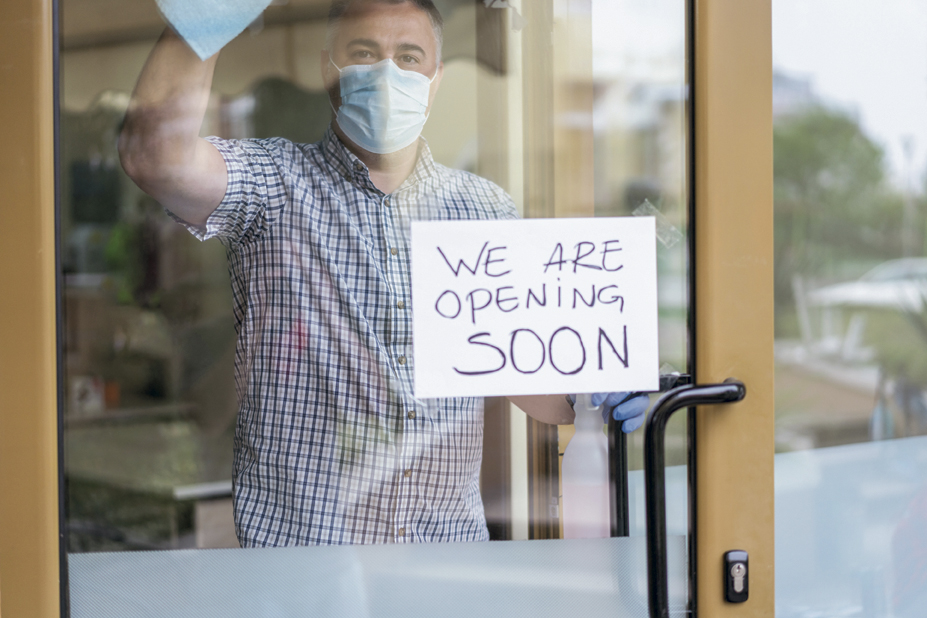PLANNING TO REOPEN
Zywave webinar shares tips for reopening office spaces after COVID-I9 stay-at-home orders end
By Christopher W. Cook
“Plans are worthless, but planning is everything.”
—Dwight Eisenhower
In mid-March, stay-at-home orders began to be issued across the country to flatten the curve of the COVID-19 pandemic. Fast forward a few months and it’s time to start gradually reopening businesses in various stages, depending on where you live. More populated areas might be on a slower timeline, and some states never put a statewide stay-at-home order into effect in the first place. Long story short (too late), businesses are reopening their doors, and it’s slowly becoming business as usual in a new normal.
What’s your reopening plan? The Eisenhower quote referenced is so appropriate at times like this, especially with how everything is changing so frequently.
To help with those preparations, Zywave, a Milwaukee, Wisconsin-based software company providing services and products for the insurance and financial planning sectors, hosted a webinar in late May appropriately titled “Developing a Return to Work Action Plan.”
While the webinar tackled additional topics like employee well-being and digital interviews and onboarding, in this article we will be discussing the aspects of physically opening up the office.
“Local and state guidelines are changing and are different throughout the country,” said Jamie Nelson, Zywave’s team lead of market specialists, who served as the webinar’s moderator. “When you put together a return-to-work plan, it’s going to have to be agile, flexible, and balanced.
“We don’t know what’s going to happen. There’s a strong case for nonlinear recovery. You need to be continually planning and continually updating. If you take what you think today is your 100% gospel and don’t make adjustments to it, week by week, month to month, that will fail.
“You need a balanced approach, meaning legal requirements, awareness of uncertainties, and safety of your employees and customers.”

—Matt Derus
Content Attorney and Market Specialist
Zywave
Where do you begin? What’s that first step toward moving your business forward? Or what if one of your clients comes to you with questions about reopening their business; what do you tell them? Have I mentioned “planning” yet?
“Employers that thoughtfully constructed return-to-work action plans with a hefty focus on the health and safety of their employees tend to find more success,” said panelist Matt Derus, content attorney and market specialist with Zywave.
“Even after the government allows businesses to reopen, those businesses still need to determine whether it make ssense to resume their operations. Safely restarting your business won’t be as simple as unlocking the front door. Before jumping into creating a plan, we would first suggest conducting a risk assessment.”
The risk assessment includes identifying the hazards and unique exposures of the business, determining who might be harmed and how it might come about, assessing the risks facing the business and analyzing them for potential consequences, and contemplating how to address those risks.
“If you’re happy with where your business stands at the completion of those steps, then you can begin to create your return-to-work action plan,” said Derus.
A first step should be creating a comprehensive pandemic response team that will “deploy clear-communication so that your company is on the same page when it comes to your return-to-work action plan,” added Derus. “Ideally, this team would include both managers and rank-and-file employees, as each have a crucial role to play.
“Employers should then prepare for reopening by first examining how to modify their work facility. These workplace modifications should be based on social-distancing protocols, which may also be required by state orders as a condition of permission to reopen.”
Derus shared three key-modification factors:
- Physical. e.g., adding partitions to the floorplan
- Protocol. e.g., prohibiting in-person meetings
- Scheduling. e.g., staggering start times
“Lastly, we would recommend creating employee-safety-training materials,” Derus said. “Your plan is largely contingent on how well your employees follow your health and safety guidance. These materials should address social-distancing guidelines, which vary by locality; the use of personal protection equipment (PPE); personal hygiene and etiquette, and cleaning responsibilities.
“With your plan in place and your business ready to reopen, employers should remain cautious to open in a manner consistent with the health and safety of their employees. Employers should, in doing so, repeatedly monitor federal, state, and local guidance to ensure compliance as it’s constantly changing.”
One concern employers might have is making sure sick employees or visitors don’t enter the building.
“Since the Centers for Disease Control and Prevention (CDC) and other government authorities have acknowledged community spreading of COVID-19 and have issued precautions, temperature taking has become an acceptable practice for employers,” said Derus. “Employers are allowed to take daily temperature checks for employees before they enter the workplace.”
Remember to double check with the most up-to-date guidelines. Another consideration is businesses that are covered under the Americans with Disabilities Act (ADA).
“The ADA requires that all medical information be stored separately from the employee’s personnel file,” said Derus. “Employers can store all medical information related to COVID-19 in existing medical files, as long as that’s separate from personnel files. Medical files can include an employee statement that they have the virus, suspect they have the virus, or other documentation from questioning an employee about symptoms related to the virus.”
Derus stressed the importance of communicating with employees ahead of time to make sure everyone has an adequate heads up regarding screening and temperature-taking procedures.
“Ensure that your employees understand the implications of testing,” he added, “meaning that if they are found to have a high temperature, they’re going to be sent home no matter what.”
He also recommended the use of no-touch thermometers to avoid spreading illness, locating checking stations at a safe distance from the workplace entrance, and maintaining disinfecting procedures at the stations.
As for wearing masks or other face coverings? “By now, most employers know that the CDC has advised that face coverings should be worn in public,” Derus said. “As far as requiring face coverings, organizations should consider what kinds of services they provide and also check with their local guidelines. Unless providing critical services, most employers want to consider requiring employees to use cloth face coverings rather than masks, as masks are typically reserved for healthcare workers.
“Employers will also want to have policies and procedures in place for the use of face coverings. Address who’s expected to wear them and how they will be supplied—whether the employer is going to be supplying them or whether each individual has to bring one to work. Also consider the appropriate technique for wearing a face covering. Employers definitely want to communicate their face-covering policies and procedures to all employees.”
While businesses reopen, some employees might still consider it unsafe to leave their house and might even refuse to come back. What if this scenario happens to you or one of your clients?
“An employee’s refusal to return to work upon the reopening of a business will create a wide array of considerations for the employer; these considerations are inherently legal and frankly should be discussed with your local legal counsel,” said Derus. “An employer in such a situation must consider whether the employee’s refusal to return to work is reasonable in light of the measures taken to mitigate the risk of COVID-19 in the workplace.
“Another consideration is whether the employee has a covered disability that must be accommodated under the Americans with Disabilities Act, or whether the employee is entitled to leave under a multitude of leave law. It’s a very complicated analysis, and employers will be well advised to involve their employment counsel to assist them at the outset.

—Jamie Nelson
Team Lead, Market Specialists
Zywave
“In the instances we’ve seen where an individual refuses to return to work because maybe they’re making more money from unemployment insurance than they make while working, employers can inform such an individual that their offer to return to work has been reported to the state government,” he continued. “So if they refuse to return to work, in many instances they’re not going to be able to collect those benefits. It depends on the situation; it’s not a hard-and-fast rule.”
For businesses that have been operating differently (e.g., working remotely) during the course of the COVID-19 stay-at-home orders—or any business in general—now would also be a good time to reevaluate and update company policies and procedures.
“As businesses transition back to their normal operations, communication with employees is a critical component,” said Derus. “Employers may want to consider having written policies addressing various issues that have popped up since COVID-19 has come about. We recommend reviewing all preexisting policies that were changed formally or in practice as a result of COVID-19. One that really stands out would be remote-work policies.
“Additionally, we recommend reviewing policies that were affected by COVID-19 concerns. Examples might be attendance policies, working hours, timekeeping, and PTO.”
Employers covered by the Families First Coronavirus Response Act (FFCRA) will need to revise their sick leave and FMLA policies to address the Emergency Paid Sick Leave Act (EPSLA) and the Emergency FMLA Expansion Act, if they haven’t already done so. Derus also mentioned “potentially relaxing attendance policies to encourage sick employees to stay home. Your current policies may put undue pressure on employees to come to the worksite when they feel ill. Consider how that may affect the spread of COVID-19 and, on a broader scale, the health of your organization in general.
“Amend and update any policies related to workplace disinfecting,” he continued. “Draft specific procedures on reporting COVID-19 exposures or symptoms, as well as temperature checks and generalized COVID-19 test data. Consider addressing safety-related concerns that employees may have. You might want to send employees a survey to gauge their concerns and thoughts prior to returning to the workplace.”
Derus also recommended written policies for hygiene and social distancing. Consideration can be given to flexible scheduling options to stagger employee shifts, which might include adjustments to meal break policies.
Create protocols regarding vendors, visitors, and non-employees who may be present at your worksite. “It does seem that many organizations took for granted the free flow of visitors to the worksite pre-COVID-19,” Derus said. “For the near future, procedures for allowing visitors on campus will need to be amended.”
While the situation continues to change rapidly, “Employers don’t need to have written procedures for everything,” Derus continued. “In some instances, it may not be practical to draft a written procedure when that procedure would just need to be updated a day or two afterwards. The main takeaway is that employers will want to review policies prior to bringing their employees back to work.”
As the country’s economy slowly reopens, keep this information in mind for your business and those of your clients. Stay up to date on federal and state guidelines, and remember that the safety and health of your employees and clients is top of the list. Plan to prepare, but prepare for plans to change.
For more information:
Zywave
www.zywave.com






